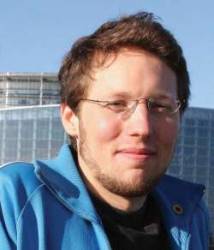 Jules McNeff, Overlook SystemsTechnologies, Inc.
Jules McNeff, Overlook SystemsTechnologies, Inc.EDITOR’S NOTE: The special “GNSS Forum” continues the discussion of spectrum sharing and protection addressed in the “Thought Leadership Series” in this issue of Inside GNSS.
Some research has gone into the possibility of using other parts of the RF spectrum for GNSS services in addition to L-band, for instance, S-band frequencies. What are the most important technical and practical considerations that come to mind in considering such proposals?
EDITOR’S NOTE: The special “GNSS Forum” continues the discussion of spectrum sharing and protection addressed in the “Thought Leadership Series” in this issue of Inside GNSS.
Some research has gone into the possibility of using other parts of the RF spectrum for GNSS services in addition to L-band, for instance, S-band frequencies. What are the most important technical and practical considerations that come to mind in considering such proposals?
L-Band comprises a very favorable portion of the RF spectrum — that’s why it is called “beach-front property” and is so valuable to service providers and users. From a GPS/GNSS perspective, it is beneficial for satellite transmission electronics and power, for transmissibility through the atmosphere, and for reception by a variety of receiver configurations from handheld to “full-size” using reasonably sized antenna elements.
While there have been and are initiatives to broadcast RNSS signals in other parts of the spectrum, particularly S-/C-Band(s), each involves additional compromises in signal generation, transmission, and reception. First, since the current RNSS allocations are already at the upper end of the L-Band, a move up to S-Band would still involve the same crowding and sharing issues, as the S-Band spectrum is also valuable property. Next, without getting enmeshed in details, at higher frequencies, generation and transmission of the RNSS signals become more electronically complex for satellite design and requires more power, as atmospheric signal attenuation is more of a factor, and receiver antenna and front end designs become issues for manufacture and sale of affordable GNSS-enabled electronic devices.
It should also be noted, in the context of this alternate frequency discussion, that current RNSS allocations permit operation of GNSS services in multiple parts of the L-Band spectrum. Before contemplating a migration to other locations, I would suggest that the GNSS community first extract all possible benefits of using the allocations available to it within the L-Band. With the ongoing modernization of the GPS civil signal complement (L2C, L5, and L1C) and the emergence of other GNSS civil services over the next several years, the ability of civil users to exploit multi-frequency PNT for critical applications will help mitigate the effects of transitory interference events in any particular part of the spectrum. Although this is more costly than single-frequency operations at L1, it is less so — in terms of all the actions that would be necessary — than moving to completely different parts of the spectrum.
How important do you think commercial pressures are in policy making about spectrum allocation? Are GPS and other GNSS systems at a disadvantage because the absence of direct user charges makes it somewhat more difficult to gauge their economic contributions?
Competitors look for spectrum that appears under-utilized or for which they can justify arguments for increased value application and then push for regulatory changes. Since the outcomes of these competitive initiatives represent profitable market opportunities and advantages for the winners and consequent losses in revenue and costs of relocation or reengineering for the losers, the commercial pressures are unrelenting.
Government regulators referee the competition as best they can among not only the purely commercial interests but also among the “public good” aspects, which include national security, public safety, scientific research and other applications in the public interest. In many cases, arguments for those applications cannot be made on the same dollar-for-dollar basis as the commercial applications and so must rely on other quantitative measures of merit to justify their spectrum access benefits.
In the case of GNSS services, these are more difficult to quantify because they are both direct and indirect, include second- and third-order benefits, and are not simply revenue streams from direct subscription services. They are spread across all economic sectors and represent revenues from increased efficiencies in logistics and related economies of operation, improved safety, reductions in personnel costs and exposure to hazards, and others. For example, how does one assess the difference in value between broadband transmission of digital data for entertainment purposes versus the precise PNT-enabled fidelity of other digital content for national or homeland security purposes or the continuity of precise navigation signals for aviation, maritime, or terrestrial safety of life. It is a very difficult proposition.
Also, in my view, the absence of direct user charges for GNSS services is not a disadvantage because the fundamental user value models are different for GNSS than for communications services, for which users historically expect to pay subscription fees. For GPS and GNSS services, the value to the U.S. economy (and others) comes not from any direct subscription fees, but from the economic and human benefits that I have noted earlier.
Ultimately, it is incumbent on the GNSS community to develop and marshal quantitative arguments based upon these factors to continue justifying preservation of the RNSS allocations already established and to maintain the continued viability of those allocations in the face of the relentless commercial pressures to squeeze in among or “share” them. These, along with the other spectrum use and advocacy measures I mention in the previous sections, should comprise the core of a continuing education program by GPS and GNSS industry for government resource sponsors, for spectrum regulators and for users of GNSS services to build an enduring base of support for preservation of GNSS spectrum.






